The e-Japan Journal is the electronic webletter of the Consulate General of Japan at Chicago and the Japan Information Center (JIC). We hope it proves to be a useful, interesting, and exciting window for you into Japanese cultural activities happening throughout the Midwest. As always, your feedback, comments, and suggestions are encouraged and can be sent to our editor, Amy Klouse, at jic@cg.mofa.go.jp.
|
|
| This Month in Japan |
|
|
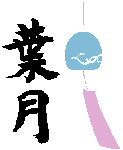 Hazuki is the shortened form of Haochizuki, or "leaf-falling month" and is the traditional Japanese way to say August. When Japan followed a lunar-based calendar system, Hazuki was the first month that fell in autumn, hence the name “leaf-falling month.”
Hazuki is the shortened form of Haochizuki, or "leaf-falling month" and is the traditional Japanese way to say August. When Japan followed a lunar-based calendar system, Hazuki was the first month that fell in autumn, hence the name “leaf-falling month.”
O-bon, which takes place this month, is one of the most important celebrations of the year for the Japanese people. Bon Festivals are held to honor, remember, and be reunited with deceased ancestors. At this time of year, spirits are believed to return to their hometowns to rejoice with loved ones. A mukae-bi, or welcoming flame, is lit by families to guide their ancestors' spirits to their homes. When Bon ends, the spirits are sent off with another bonfire, called okuri-bi. Some regions release small lanterns down rivers or into the sea as part of the okuri-bi ritual.
 Return to top Return to top
|
|
|
 The Japan Foundation in Los Angeles and New York will be offering the following grants this upcoming fall. To ensure a smooth submission process, it is highly recommended that interested candidates start their applications early.
The Japan Foundation in Los Angeles and New York will be offering the following grants this upcoming fall. To ensure a smooth submission process, it is highly recommended that interested candidates start their applications early.
 Return to top Return to top
|
| Japan Travel Program for US Future Leaders |
|
|
The Japan Foundation Center for Global Partnership (CGP), in collaboration with the Association of Professional Schools of International Affairs (APSIA), inaugurated the Japan Travel Program for U.S. Future Leaders in 2009. The goal of this program is to foster a new generation of future leaders in the United States who are interested in achieving a greater understanding of Japan and its roles in global affairs.
Each year, the program invites approximately twelve first-year graduate students of international affairs to Japan as a group. Students who currently are or previously have been engaged in Japan studies as well as those who demonstrate interest in Japan are all encouraged to apply.
Congratulations to all participants who begin the program this month. The JIC would like to applaud a select member of the 2014 program who resides within our jurisdiction, Ms. Nicole Kessler, a Master of Science in Science, Technology, and Environmental Policy candidate at the University of Minnesota’s Humphrey School of Public Affairs. Enjoy your trip to Japan!
 Return to top Return to top
|
| August 6: Twilight Samurai Film Screening @ the JIC |
|
|
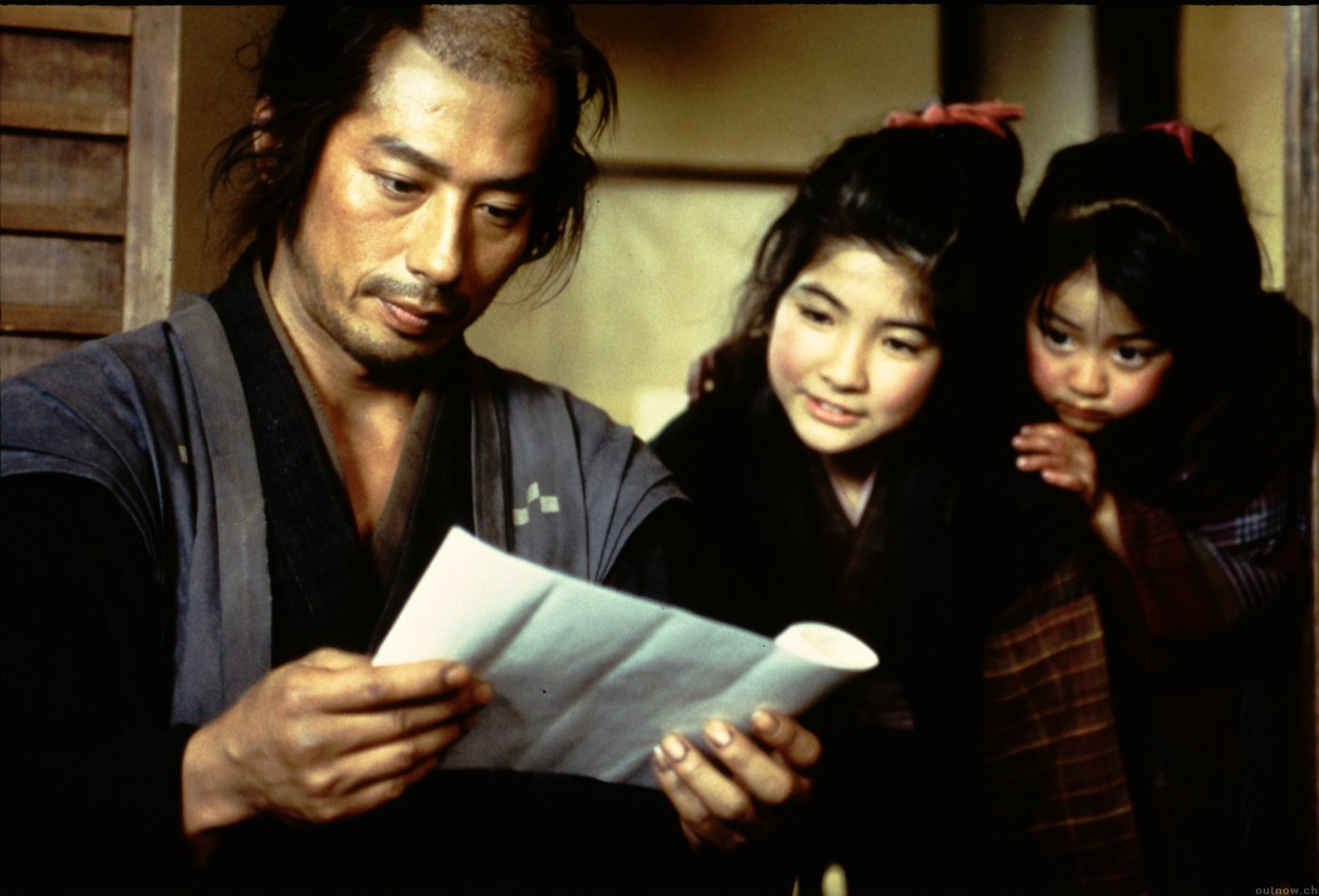 This August, the JIC is hosting a FREE special film screening to showcase the Japanese movie Twilight Samurai, an offical selection for the 39th Chicago International Film Festival in 2003! After the film's released in 2002, it became an instant classic in Japanese cinema and has won several awards including the Japan Academy Prize for Best Picture.
This August, the JIC is hosting a FREE special film screening to showcase the Japanese movie Twilight Samurai, an offical selection for the 39th Chicago International Film Festival in 2003! After the film's released in 2002, it became an instant classic in Japanese cinema and has won several awards including the Japan Academy Prize for Best Picture.
Directed by Yoji Yamada, this beautifully crafted elegy follows a reluctant, low-ranking samurai in Japan's vanishing fuedal era before the Meiji Restoration. Iguchi's life is not filled with exciting sword duels or fiece battles but, rather, with bookkeeping and household chores. When the clan's lord dies, conflict breaks out over who will be his successor, and Iguchi must set off for a fateful battle with a skillful rebel samurai.
The film is 129 minutes in Japanese with English subtitles.
| Date and Time |
Location |
Information |
August 6, 2014 (Wed)
1:00 - 6:00 PM |
Claudia Cassidy Theater
at the Chicago Cultural Center
78 East Washington Street, 2nd Floor |
Twilight Samurai Flyer |
 Return to top Return to top
|
| August 8-10: 59th Annual Ginza Festival @ Midwest Buddhist Temple |
|
|
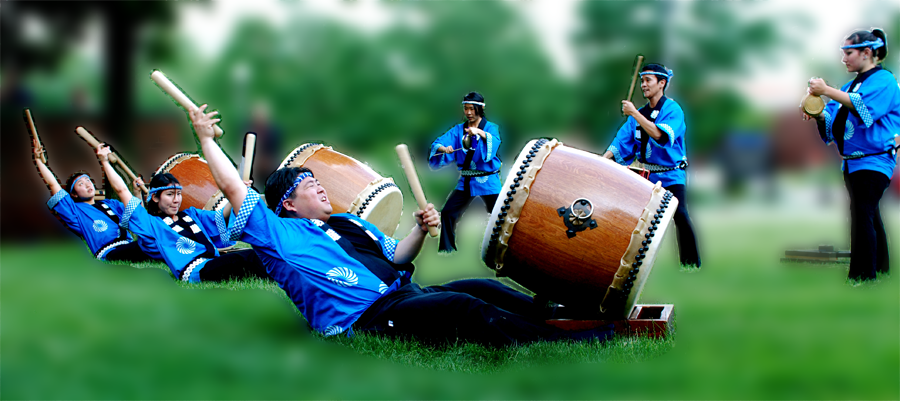 At the 59th Ginza Festival, expect to enjoy an abundance of traditional Japanese culture, cuisine, and fun throughout the weekend at the Midwest Buddhist Temple!
At the 59th Ginza Festival, expect to enjoy an abundance of traditional Japanese culture, cuisine, and fun throughout the weekend at the Midwest Buddhist Temple!
Four master craftspersons (waza) will demonstrate generations-old skills creating unique craft items. Visitors will have the chance to meet these talented individuals and purchase their items in addition to other Japanese textiles, snacks, t-shirts, kimono, artwork, and jewelry. Tasty food offerings include a grilled chicken teriyaki dinner, udon (Japanese cold noodles), sushi, spam musubi, edamame, and grilled corn on the cob. Kintoki (a Japanese snow cone topped with sweet azuki beans) and Japanese beer will also be available.
As for entertainment, expect ongoing stage performances with Ho Etsu Taiko and MBT Taiko; the MBT Minyo Group; Fujima Ryu of Chicago (classical Japanese dance troupe); Na Kupuna Ukulele Group; Aikido, Judo, and Karate; while Yoko Noge and her band Japanesque will play Saturday evening beginning at 8:00 PM. Inside the temple, the exhibit hall will have bonsai, ikebana (flower arranging), calligraphy, brush painting, jewelry, cards, and Japanese arts and crafts. Moreover, the temple will be open for visitors who wish to worship and learn the basics of Buddhisim. During intermissions, Reverend Ron Miyamura will deliver short Dharma talks.
For more information, you may contact The Midwest Buddhist Temple at 312-943-7801 or Joy Zavala, Ginza Publicity Chairperson, at info@ginzachicago.com.
| Date and Time |
Location |
Information |
August 8-10, 2014 (Fri-Sat)
Fri 5:30 - 9:00 PM
Sat 11:30 AM - 9:00 PM
Sun 11:30 AM - 6:00 PM |
Midwest Buddhist Temple
435 West Menomonee Street
Chicago, IL 60614 |
Ginza Festival website
Adults: $7
Students and seniors: $6
Yoko Noge concert: $12
Weekend pass: $15
(Free for children 12 and under) |
 Return to top Return to top
|
| August 15: Ethnic Enrichment Festival with the Heart of America Japan America Society |
|
|
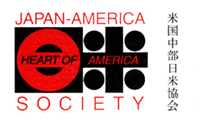 Approximately 60 countries/cultures are represented during this three-day event which attracts people from all over the Midwest. If you visit and purchase an item from the Japan booth, it's for a good cause. All proceeds will help to support the Heart of America Japan America Society's Student Ambassador Fund and Scholarship Fund.
Approximately 60 countries/cultures are represented during this three-day event which attracts people from all over the Midwest. If you visit and purchase an item from the Japan booth, it's for a good cause. All proceeds will help to support the Heart of America Japan America Society's Student Ambassador Fund and Scholarship Fund.
As always, the food, goods items, and martial arts demonstrations are a popular hit with the crowds. Enjoy onigiri, edamame, inarizushi, chicken teriyaki, kakigori, mugicha (Barley tea), and more at the Japan stand. Try your artistic talents at the cultural booth with crafts like origami or calligraphy.
At the Consulate's booth, JET Alumni Association (JETAA) members will be there to provide information on the JET program and JETAA. Be sure to stop by to learn more about teaching in Japan!
| Date and Time |
Location |
Information |
August 15-17 (Fri-Sun)
Fri 6:00 - 10:00 PM
Sat 12:00 - 10 PM
Sun 12:00 - 6:00 PM |
Swope Park
6600 Swope Park
Kansas City, MO/KS 64130 |
● Free parking
Adults: $3
(Free for children 12 and under) |
 Return to top Return to top
|
| August 27: “Large-scale Calligraphy Demonstration and Hands-on Workshop” at the JIC |
|
|
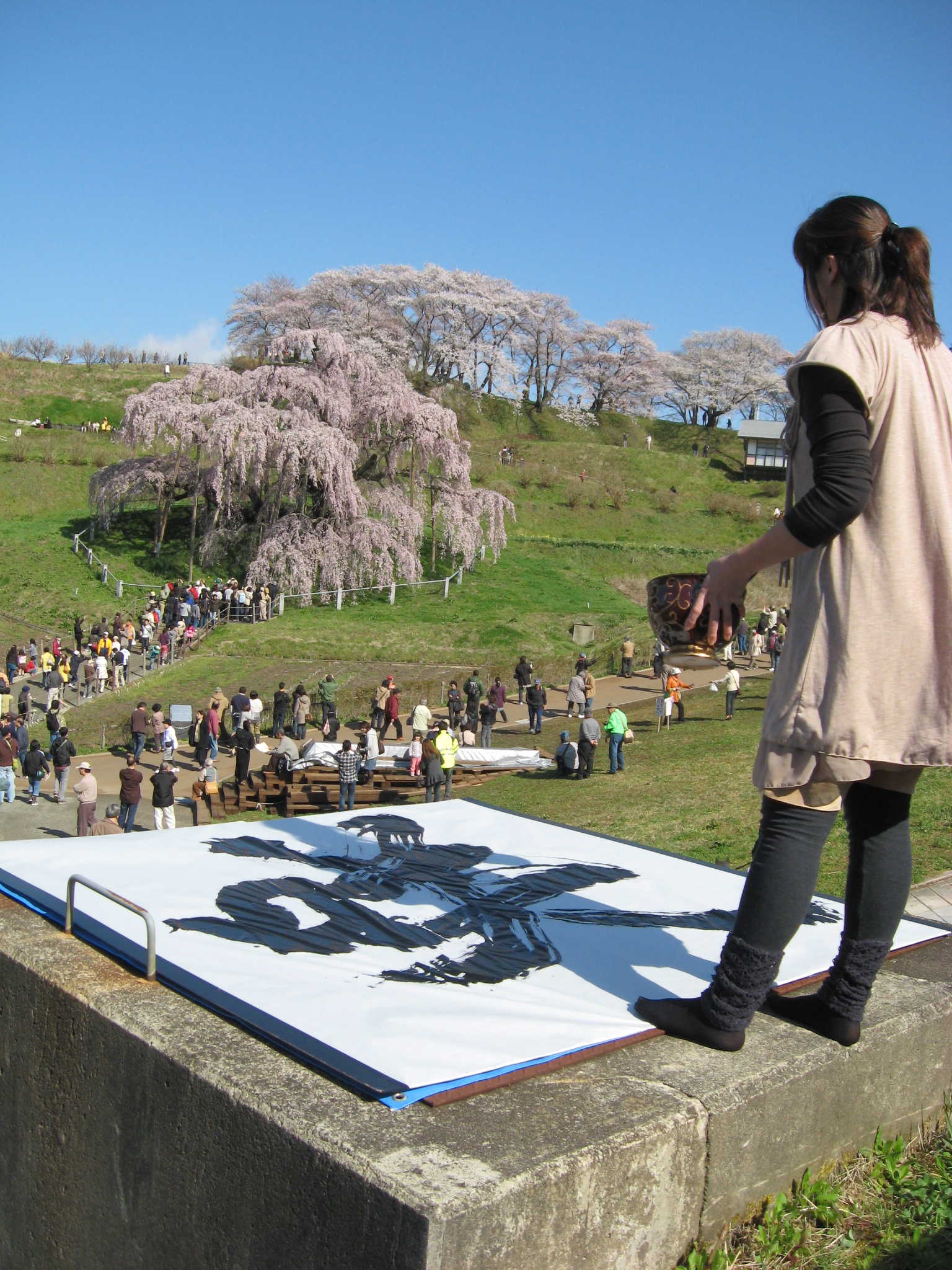 This month, the JIC is pleased to welcome back Ms. Seiran Chiba, Calligrapher and Attaka Fukushima Tourism Ambassador, for a large-scale calligraphy (shodō) demonstration! Participants will be able to take home their own beautiful works at the conclusion of the event.
This month, the JIC is pleased to welcome back Ms. Seiran Chiba, Calligrapher and Attaka Fukushima Tourism Ambassador, for a large-scale calligraphy (shodō) demonstration! Participants will be able to take home their own beautiful works at the conclusion of the event.
Chiba-san has visited all 59 towns and villages in Fukushima to give live presentations. Additionally, she has traveled to other regions of Japan, including the town of Miharu, where her work "Saku Warau" (bloom laughter) was donated to the Miharu local government.
Due to limited space, reservations are required and can only be granted to the first 40 interested guests. If interested, please RSVP for the event by Friday, August 22!
You can view pictures here from last year's Large-scale Calligraphy Demonstration.
| Dates |
Location |
Information |
August 27, 2014 (Wed)
6:00 - 7:30 PM |
Japan Information Center
737 N. Michigan Avenue, Suite 1000
Chicago, IL 60611 |
JIC Calligraphy Flyer |
 Return to top Return to top
|
| August 30-Sept 1: Japanese Festival with the Japan America Society of St. Louis |
|
|
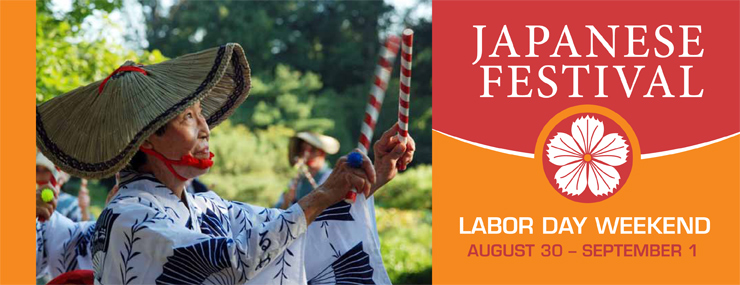 Celebrating the history, culture, and people of Japan, the Japanese Festival at the Missouri Botanical Garden is one of the largest and oldest festivals of its kind in the United States.
Celebrating the history, culture, and people of Japan, the Japanese Festival at the Missouri Botanical Garden is one of the largest and oldest festivals of its kind in the United States.
Since 1977, the Missouri Botanical Garden has produced the annual Japanese Festival in conjunction with the Japanese Activities Committee, a coalition of several Japanese-American organizations that provide art, dance, food and entertainment for thousands of visitors each year. The celebration kicks off Saturday morning with a lively performance by taiko drummers at the Japanese Garden entrance. You can extpect the festival highlights to include tea house island tours, an elaborate omikoshi Shinto shrine parade, bon odori festival dancing, traditional music performances, martial arts demonstrations (including sumo), bonsai displays, and many more fun family activities. As always, there will be sushi and other Japanese snacks available for purchase!
 Return to top Return to top
|
| September 1: Registration for the Japanese Language Proficiency Test OPENS |
|
|
 The Japanese Language Proficiency Test (JLPT) takes place annually in December and this year, registration opens at the beginning of September. The JLPT measures comprehensive Japanese-language communicative competence through three elements: "Language Knowledge," "Reading," and "Listening." There are five levels offered, with N5 being the least difficult and N1 being the highest level. The test challenges your progress in Japanese language studies and if you pass, it can be used as a benchmark to indicate your level of proficiency.
The Japanese Language Proficiency Test (JLPT) takes place annually in December and this year, registration opens at the beginning of September. The JLPT measures comprehensive Japanese-language communicative competence through three elements: "Language Knowledge," "Reading," and "Listening." There are five levels offered, with N5 being the least difficult and N1 being the highest level. The test challenges your progress in Japanese language studies and if you pass, it can be used as a benchmark to indicate your level of proficiency.
The American Association of Teachers of Japanese website has more information on the test and provides useful advice on what steps you can take to prepare for the exam.
 Return to top Return to top
|
|
 |
If you have any questions, comments, or suggestions, feel free to contact our librarian directly at emily.toelcke@cg.mofa.go.jp.
|
|
| This month's Highlighted Resources was written by JIC Summer Intern Alexandria Santos and features a selected literary work from our library. |
| ------------------------------------------------------------------------------------------------------------------------------------------------ |
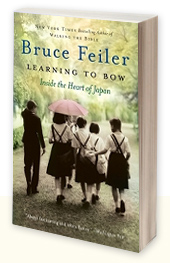 The JIC ended July with the send-off of this year’s JET Program participants. In name, the JET Program provides college graduates with the opportunity to work in Japan as English teachers or aids to the local government. However, it also serves as a way to bridge the cultural gap between the U.S and Japan. In JET alumni, Bruce S. Feiler’s book, Learning to Bow: Inside the Heart of Japan (Call Number 471036), readers learn about how the program accomplished that for him.
The JIC ended July with the send-off of this year’s JET Program participants. In name, the JET Program provides college graduates with the opportunity to work in Japan as English teachers or aids to the local government. However, it also serves as a way to bridge the cultural gap between the U.S and Japan. In JET alumni, Bruce S. Feiler’s book, Learning to Bow: Inside the Heart of Japan (Call Number 471036), readers learn about how the program accomplished that for him.
Throughout the book, Feiler covers a variety of topics about Japan. From communal bathing to dating a Japanese girl, he offers readers his first-hand experiences with Japanese culture and customs. Better yet, his writing style is both humorous and refreshingly informative. The accounts of his experiences are honest and unassuming. Through this, he promotes the idea that neither nation’s culture is “wrong” or inherently strange, but simply different, and, that by coming to understand these differences, one can begin to bridge the cultural gap.
Foreignizing text is a highly debated practice in the field of literary translation. It is a question of how complete a translation can be without losing the cultural origins of the text. Basically, if the author over-translates, readers might forget the characters are speaking Japanese, but if the author doesn’t translate enough, the readers will have a hard time understanding what is happening. In Learning to Bow, Felier frequently utilizes Japanese for greetings (e.g. Ohayou gozaimasu! versus translating to “Good morning!”) and cultural objects (e.g. katana versus translating to “samurai sword”). However, he successfully clarifies any possible confusion by also including a Japanese to English glossary at the end. Felier even takes it a step further by making a special note of the words he believes are “the main pillars of Japanese educational philosophy.” By doing this, the novel is a fun read with educational benefits!
As an East Asian Languages and Cultures major attending a university largely known for its engineering program, I frequently am questioned about what I want to do. The short answer is teaching. The longer, more accurate, but also vaguer answer is that I want to play an active role in bridging the culture gap between the U.S. and Japan. This month, I set out to find a book in our library that would better explain what that meant, and in Bruce Feiler’s Learning to Bow: Inside the Heart of Japan, I found an insightful novel that did just that.
 Return to top Return to top
|
|
| New Additions showcases the latest materials we have received in the JIC collection. |
| ------------------------------------------------------------------------------------------------------------------------------------------------ |
|
 Return to top Return to top
|
|
|
Here are some questions about current events in Japan. Email your answers for the chance to win a small prize!
- Which Japanese actor will play the king in New York’s Broadway musical “The King and I?”
- What is the name of the last surviving crewmember of the Enola Gay, who passed away this month?
- What is the name of the newest Dragon Ball movie, scheduled to be released in Spring 2015?
--------------------------
No winner from the July issue, although we had some close guesses! Here are last month's answers: |
• What continent is Japan considering building a new scientific research lab on?
Antarctica
• Which popular cartoon from Japan will start being aired in the United States on July 7?
Doraemon
• Who is the famous Japanese soccer star that will be a voice actor in an upcoming Pokémon film?
Atsuto Uchida
 Return to top Return to top
|
|
 Children's Books of Japanese Children's Books of Japanese
Are you hoping to teach your son or daughter some Japanese in the future, or would you like to start learning the essentials of the language yourself? If so, one of the best ways to start learning is through reading children’s books. This is especially true for works that are written in both English and Japanese because direct comparisons between languages can easily be made. In some books, both languages are present on two pages side-by-side, in others the entirety of text found is in English first and then followed by the Japanese translation. Still others require strictly English and Japanese versions separately. It is important to know that these differences exist to avoid unintended surprises when purchasing!
The website highlight for August is a list of children's books that are available on Amazon. This is not exclusively where book lists can be found, but it is a good starting point. If you have any recommendations you would like JIC staff to read or even order for the library, please email us and let us know!
 Return to top Return to top
|
|
For many of our readers, August is the “last month of freedom” before students head back to school to continue their studies. Good luck to all students as you continue forward!
In Japan, it is also the month of O-bon, an annual event founded on Buddhist beliefs and traditions that commemorate deceased ancestors. In some parts of Japan, the event is celebrated in July while in others it occurs in August. This discrepancy of dates is rooted in differences between the solar and lunar calendars and when Japan changed calendars, some regions maintained celebrating holidays according to the lunar date while others adapted to the new solar date. Typically, August 9-17 is the busiest travel period for the O-bon holiday period. If you plan to visit Japan during this time, be prepared for crowds and more expensive travel!
Best,
Amy Klouse (Editor, Technology and Information Coordinator)
|
Villagers dancing bon-odori
 |
 Return to top Return to top
|
| |
| You are receiving this email webletter because you have signed up to receive information about Japan and Japan-related events from our office. If you no longer wish to receive these emails, please email the Japan Information Center at jic@cg.mofa.go.jp. |
| |
Official website for Consulate General of Japan at Chicago
www.chicago.us.emb-japan.go.jp |
|
|